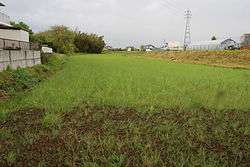Yūki Domain
Yūki Domain (結城藩, Yūki-han) was a feudal domain under the Tokugawa shogunate of Edo period Japan, located in Shimōsa Province. It was centered at Yūki castle in what is now part of the city of Yūki, Ibaraki. It was ruled for most of its history by a branch of the Mizuno clan.

History
The Yūki clan was one of the eight leading samurai clans of the Kantō region from the Kamakura period. A younger son of Tokugawa Ieyasu, Hideyasu has been adopted by Toyotomi Hideyoshi as a possible heir, and after the birth of Hideyoshi's son, was sent to become heir to the Yūki clan instead, adopting the name of Yūki Hideyasu. Following the Battle of Sekigahara, he was confirmed as daimyō of Yuki Domain in 1590, ruling until his transfer to Fukui Domain in 1601. The domain reverted to tenryō status, and remained vacant until the Genroku period.
In 1700, Mizuno Katsunaga, daimyo of Nishiya Domain in Noto Province was transferred to the revived Yūki Domain, where his descendants resided until the Meiji Restoration. During the Boshin War, the domain was divided between supporters of the imperial cause, and supporters of the shogunate. The 10th daimyō, Mizuno Katsumoto had been adopted into the clan from Nihonmatsu Domain and was a strong supporter of the Tokugawa, whereas his adopted son and heir, Mizuno Katsuhiro supported the imperial side. Katsumoto assisted Tokugawa partisans capture Yūki castle, but his son assisted in its re-capture by pro-imperial troops. Katsuhiro was punished by the Meiji government with a reduction in revenues of 1000 koku and exile from the domain. Katsuhiro eventually became domain governor and presided over the absorption of the former domain into Ibaraki Prefecture in 1871 after the abolition of the han system.
Holdings at the end of the Edo period
As with most domains in the han system, Yūki Domain consisted of several discontinuous territories calculated to provide the assigned kokudaka, based on periodic cadastral surveys and projected agricultural yields.[1][2]
- Shimōsa Province
- 13 villages in Yūki District
- Kazusa Province
- 2 villages in Yamabe District
- 16 villages in Musha District
- Hitachi Province
- 1 village in Ibaraki District
- 12 villages in Makabe District
- Shimotsuke Province
- 3 villages in Suga District
- 10 villages in Haka District
List of daimyōs
| # | Name | Tenure | Courtesy title | Court Rank | kokudaka |
|---|---|---|---|---|---|
| 1 | Yūki Hideyasu (結城秀康) | 1594–1600 | Mikawa-no-kami (三河守) | Lower 4th (従四位下) | 100,000 koku |
| 1 | Mizuno Katsunaga (水野勝長) | 1700–1703 | Oki-no-kami (隠岐守) | Lower 5th (従五位下) | 18, 000 koku |
| 2 | Mizuno Katsumasa (水野勝政) | 1703–1736 | Hyūga-no-kami (日向守) | Lower 5th (従五位下) | 18,000 koku |
| 3 | Mizuno Katsunobu (水野勝庸) | 1736–1749 | Hyūga-no-kami (日向守) | Lower 5th (従五位下) | 18,000 koku |
| 4 | Mizuno Katsuchika (水野勝前) | 1749–1763 | Hyūga-no-kami (日向守) | Lower 5th (従五位下) | 18,000 koku |
| 5 | Mizuno Katsuoki (水野勝起) | 1763–1783 | Hyūga-no-kami (日向守) | Lower 5th (従五位下) | 18,000 koku |
| 6 | Mizuno Katsukata (水野勝剛) | 1783–1800 | Hyūga-no-kami (日向守) | Lower 5th (従五位下) | 18,000 koku |
| 7 | Mizuno Katsuzune (水野勝愛) | 1800–1835 | Hyūga-no-kami (日向守) | Lower 5th (従五位下) | 18,000 koku |
| 8 | Mizuno Katsuyuki (水野勝進) | 1835–1859 | Hyūga-no-kami (日向守) | Lower 5th (従五位下) | 18,000 koku |
| 9 | Mizuno Katsuto (水野勝任) | 1859–1862 | Hyūga-no-kami (日向守) | Lower 5th (従五位下) | 18,000 koku |
| 10 | Mizuno Katsutomo (水野勝知) | 1862–1869 | Hyūga-no-kami (日向守) | Lower 5th (従五位下) | 18,000 → 17,000 koku |
| 11 | Mizuno Katsuhiro (水野勝寛) | 1869–1871 | Hyūga-no-kami (日向守) | Lower 5th (従五位下) | 17,000 koku |
References
- Papinot, E (1910). Historical and Geographic Dictionary of Japan. Tuttle (reprint) 1972.
- Kodama Kōta 児玉幸多, Kitajima Masamoto 北島正元 (1966). Kantō no shohan 関東の諸藩. Tokyo: Shin Jinbutsu Ōraisha.
External links
- Yūki on "Edo 300 HTML" (in Japanese)
Notes
- Mass, Jeffrey P. and William B. Hauser. (1987). The Bakufu in Japanese History, p. 150.
- Elison, George and Bardwell L. Smith (1987). Warlords, Artists, & Commoners: Japan in the Sixteenth Century, p. 18.